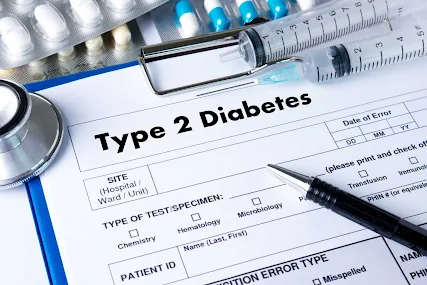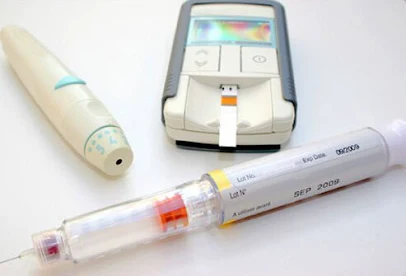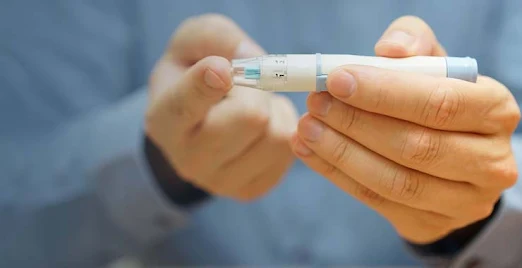11 Long Term Effects of Type 2 Diabetes in the body and Complications Associated With It
RELATED: 19 Warning Signs of Type 2 Diabetes, Diagnosis and Treatments
Differences between Type 2 Diabetes Compared to Type 1 Diabetes and Gestational Diabetes.
Type 2 diabetes (Non-Insulin-dependent diabetes) is a type of diabetes is more common. Many sufferers compared with type 1 diabetes, especially in adults, although it is possible also attacked teenagers. Type 2 diabetes is caused by cells that were subjected to insulin fail or unable to respond to insulin normally, or so-called insulin resistance.
Patients with type 2 diabetes may also arise disorders impaired insulin secretion and hepatic glucose production is excessive. But there was no destruction of Langerhans ‘β’ cells in autoimmune diabetes as occurs in type 1 insulin function decline in patients with type 2 diabetes are only relative, not absolute. (How to Cook Rice for Diabetic Patient?)
Diabetes is generally characterized by symptoms of frequent of urination, frequent of thirst, ‘Polyphagia’ (frequent of hungry), and weight loss. Other symptoms that are usually found at the time of diagnosis include a history of blurred vision, itching, peripheral ‘Neuropathy’, recurrent vaginal infections, and fatigue. Nevertheless, many people didn’t experience any symptoms in the first few years and newly diagnosed on routine examination. Patients with type 2 diabetes rarely come up in conditions very high blood glucose levels are associated with decreased consciousness and low blood pressure resulting in unconscious self.
The risk of Type 2 diabetes in Caucasians ranges from 3%-6% of the total adult population. In Singapore, the frequency of diabetes increased rapidly in the last 10 years. In the United States, people with diabetes increased from 6,536,163 people in 1990 to 20,676,427 persons in 2010. In Indonesia, the incidence of diabetes ranged from 1.4%-1.6.
In general, obesity is causing interference with the work of insulin, a risk factor that is common in diabetes type 2. Most patients with type 2 diabetes are obese. In addition to an interruption in insulin, there is also damage to the cell’s response to glucose α. The type 2 diabetes can be controlled through setting nutrition and regular exercise. Intensive lifestyle changes can reduce the risk by half. Exercising regularly will still be beneficial even if the weight has decreased.
In contrast, to Type 2 diabetes is no damage β cells, Type 1 diabetes β Langerhans cell damage caused by an autoimmune reaction. So the number of people with Type 1 diabetes (Insulin Dependent Diabetes) rarely or less population, estimated at less than 5-10%. Autoimmune destruction of β cells of the pancreas gland directly lead to deficiency of insulin secretion. Insulin deficiency that causes a metabolic disorder that accompanies Diabetes Type 1. It also resulted in the pancreas in patients with Type 1 diabetes also become abnormal.
RELATED: How To Reverse Type 2 Diabetes
Type 2 diabetes has the characteristics of high blood glucose levels in insulin resistance and relative insulin deficiency. This contrast with type 1 diabetes which occur absolute insulin deficiency due to destruction of cells in the pancreas, and gestational diabetes is high blood glucose levels associated with pregnancy. Diabetes type 1 and type 2 can be distinguished by signs that appear. If there is any doubt diagnosis, antibodies can confirm the diagnosis of type 1 diabetes and levels of C-‘Peptide’ to type 2 diabetes.
In addition to Type 1 diabetes and Type 2 diabetes, there is a Gestational Diabetes. Gestational diabetes is diabetes circumstances that arise during pregnancy and usually lasts only temporarily. This occurs due to the formation of the hormone in pregnant women that led to insulin resistance.
Complications In Type 2 Diabetes
In the United States, diabetes cause of End-Stage Renal Disease (ESRD), lowering Nontraumatic amputation, and adult blindness.
Since the discovery of the drug to lower blood glucose, especially after the discovery of insulin, the mortality rate due to acute complications diabetes can be decreased drastically. The survival of patients with diabetes longer and longer diabetes can be controlled. Chronic complications that can occur due to uncontrolled diabetes are:
1. Nerve damage (neuropathy)
Long Term Effects of Type 2 Diabetes on the body could be source of nerve damage. The nervous system of our body is composed of the central nervous system, peripheral nervous system, the brain and spinal cord, muscle, skin, and other organs. That regulates smooth muscle in the heart and gastrointestinal tract. This usually after persistent high blood glucose, not well controlled, and lasts up to 10 years or more. If the blood glucose was reduced to normal, sometimes nerve repair can occur. However, if the long-term blood glucose is not brought down to normal it will weaken and damage the walls of the capillaries that feed into the nerve, causing nerve damage called diabetic neuropathy (diabetic neuropathy).
Diabetic neuropathy can lead to nerves cannot send or deliver messages stimulation of nerve impulses, misdirected or delayed send. Depending on the severity of nerve damage and nerve are affected. In patients with type 2 diabetes, prevalence of neuropathy in clinical populations, ranging from 7.6%-68.0% and in studies on populations ranging from 13.1%-45.0%.
2. Kidney damage (nephropathy)
Human kidney neuron consists of two million and millions of tiny blood vessels called capillaries. The capillary serves as a blood filter. Materials that are not useful for the body to be thrown into the urine or urinating. The kidneys work 24 hours a day to cleanse the blood of toxins that enter into and are formed by the body. If there nephropathy or kidney damage, toxins cannot be removed, while proteins should be maintained kidneys leak out. The longer a person has diabetes and increasingly exposed to high blood pressure, then the patient more susceptible to kidney damage. Renal impairment in patients with diabetes is also associated with neuropathy or nerve damage.
In patients with type 2 diabetes prevalence in clinical populations ranging from 2.5%-57.0% and in studies on populations ranging from 18.9%-42.1%, while the prevalence of overt nephropathy in clinical populations ranging from 5.4%-20.0% and in research on populations ranging from 9.2%-32.9%.
READ MORE: 5 Possible Ways To Treat Kidney Stones
3. Eye damage (retinopathy)
Diabetes can damage the eyes, namely: 1) retinopathy, 2) cataract, the lens is usually clear, translucent and transparent becomes turbid preventing the entry of light and is exacerbated by the presence of high blood glucose; and 3) glaucoma, increased pressure in the eyeball that damage the optic nerve. (Signs and Symptoms of Some of the Most Common Eye Diseases)
4. Coronary heart disease
Diabetes damage the wall of blood vessels that causes the build-up of fat in the walls were damaged and constricts blood vessels. As a result, the blood supplies to the heart muscle are reduced and blood pressure increase, so that sudden death can occur. The prevalence of coronary heart disease with diabetes (both type 1 and 2) ranges from 1.0%-25.2% in population clinic and 1.8%-43.4%.
5. Stroke
Type 2 Diabetes complication also could be cause of stroke. The prevalence of stroke with diabetes (both type 1 and 2) ranges from 1.0%-11.3% in the clinic population and 2.8%-12.5% in the study population. Fifty percent of stroke prevalence ranging from 0.5%-4.3% with Type 1 diabetes and ranges from 4.1% and 6.7% with Type 2 diabetes.
ALSO READ: One Month Before Stroke Your Body Will Send You These Warning Signs
6. Hypertension
Hypertension or high blood pressure rarely causes complaints such dramatic eye damage or kidney damage. However, it should be remembered hypertension can lead to heart attack, retinopathy, kidney damage, or stroke. Risk of heart attack and stroke is doubled when diabetics are also affected by hypertension.
Damage to blood vessels in the periphery or in the hands and feet, called Peripheral Vascular Disease (PVD), may occur earlier and faster process in people with diabetes than those without diabetes. Pulsation of blood vessels in the legs feels weak or no taste at all. When diabetes lasted for 10 years, a third of men and women can experience this disorder. And if it is found besides PVD followed neuropathy and nerve disorders or infections or wounds that are difficult to heal, the patient usually has experienced a narrowing of the blood vessels of the heart.
8. Disturbances in Liver
Many people assume that if diabetics cannot eat sugar, so can damage the liver (liver). This assumption is wrong. The liver can be disrupted by the diabetes itself. Compared to people without diabetes, patients with diabetes are more susceptible to virus infection with hepatitis B or hepatitis C. Therefore, diabetics must stay away from sick people contracting hepatitis because it is easy and requires vaccination for the prevention of hepatitis. Chronic hepatitis and cirrhosis of the liver (liver cirrhosis) also easily occur because of infection or inflammation of the liver that is prolonged or repeated.
Liver disorders are often found in people with diabetes is the fatty liver or fatty liver, is usually (almost 50%) in patients with type 2 diabetes and obese. This disorder should not be allowed because it could be a sign of the accumulation of fat in other body tissues.
Patients with diabetes are more susceptible to pulmonary tuberculosis infection than ordinary people, even well-nourished patients and socioeconomically enough. Diabetes aggravates lung infections, as well as lung disease will raise blood glucose.
10. Gastrointestinal disorders
Gastrointestinal disorders in diabetic patients due to poor blood glucose control, as well as autonomic nerve disorder affecting the digestive tract. This disorder begins from the oral cavity are prone to infections, impaired sense of taste, thereby reducing appetite, to the roots of the teeth vulnerable to infection, and tooth becomes easy to date and the growth becomes uneven. The taste of obstruction, nausea, and even vomiting and diarrhoea may also occur. This is the result of autonomic nerve disorders of the stomach and intestines. Complaints eat tract disorders can also arise due to the use of drugs taken.
ALSO READ: Stomach Pains: Why Do I Get Stomach Pains After Eating?
11. Infections
High blood glucose disrupts immune function in the face of viruses or germs that make diabetics susceptible to infection. Points are susceptible to infection is the mouth, gums, lungs, skin, legs, bladder and genitals. High blood glucose levels also damage the nervous system, thereby reducing the sensitivity of the patient against infection
How to Control Type 2 Diabetes
In general, control / management of type 2 diabetes if the same as the other type, the first step that must be done is the management without medication (non-pharmacological therapy) in the form of the diet and exercise. If in this first step the management objectives have not been achieved, can be combined with pharmacological measures such as insulin therapy or oral hypoglycemic drug therapy, or a combination of both. (Can Type 2 Diabetes Be Reversed Naturally?)
Non-pharmacological therapy is done in several ways, first; Fat diet. Key to successful to diabetes is good diet. The recommended diet is foods with a balanced composition in terms of carbohydrate, protein and fat. The goals of treatment on diabetes diet are:
- Achieve and then maintain blood glucose levels closer to normal levels.
- Achieving and maintaining optimal lipid levels approaching.
- Preventing acute and chronic complications.
- Improving the quality of life.
Nutritional therapy is recommended for all patients with diabetes, the most important of all nutritional therapy is the achievement of optimal metabolic outcomes and prevention and treatment of complications.
Second; multiply sports. Exercise regularly can reduce and maintain blood sugar levels remain normal. In principle, do not need intense exercise, light exercise if done regularly will be very good for health effects. Some examples of sports that suggested, among other roads or goes jogging, cycling, swimming, and so forth. Exercise will increase the number and improve glucose utilization
2. Pharmacological therapy
Pharmacological therapy can be done with, 1. Insulin; 2. Oral anti diabetics. Insulin is a hormone that is produced from pancreatic β cells in response to glucose. Insulin has a very important to control the metabolism and spacious, the effect of insulin is to help transport glucose from the blood into the cells.
Oral anti diabetic medication intended to help treat patients with type 2 diabetes oral anti diabetic Pharmacotherapy can be done using a single drug or a combination of the two drugs.
Causes and How to Prevent Type 2 Diabetes
Although Type 2 diabetes is generally caused by obesity, but it is possible happens by other causes. Type 2 diabetes occurs as a result of a combination of lifestyle and genetic factors. There are several lifestyles that can lead to type 2 diabetes, such as diet and obesity. But there are other things other than lifestyle and also cannot be controlled such as age, gender, and genetics. Lack of sleep is also often associated with type 2 diabetes is thought to occur through the effects of sleep deprivation on metabolism. The nutritional status of the mother during fetal development during pregnancy may also act via a mechanism that is still a conjecture that DNA changes.
Lifestyle
Lifestyle is a major cause of disease onset type 2 diabetes. Lifestyles such as obesity, lack of physical activity, less or not as good nutrition, stress, and urbanization.
Studies conducted by Shoback revealed that excess body fat causes 30% of cases of diabetes in patients with Chinese and Japanese descent, 60-80% of cases in the European and African descent, and 100% of cases in Indians and Pacific Islanders. Patients who are not overweight usually have a waist-to-hip ratio were great.
Current lifestyle diet also led to the emergence of type 2 diabetes Consumption of sugar-sweetened beverages increases the risk of excessive sugar. This type of fat when the diet has an important influence. Saturated fats and trans fatty acids may increase the risk, whereas unsaturated lower the risk. Consumption of rice is too much also plays a role in increasing the risk.
Genetic
Most cases of diabetes involve many genes that each contributes an influence on the increased possibility of diabetes type 2. If one of the identical twins had diabetes, the chance of a lifetime twin brother of diabetes is more than 90% while identical twins are not only 25-50%. Up until 2011, more than 36 genes have been known to influence the risk of the emergence of type 2 diabetes combined all these new genes. There are many rare cases of diabetes arising from a single gene abnormality other. Among other things, Maturity Onset Diabetes of the Young (MODY), ‘Rabson’-Mendenhall and ‘Donohue’ syndrome,. MODY amounted to about 1-5% of all cases of diabetes in young people.
Medical Conditions
If ever done some particular treatment the higher the risk of developing diabetes. Some of these medications include: Glucocorticoids, Thiazides, beta blockers, atypical Antipsychotics, and Staten. Other health problems relating, among others, acromegaly, hyperthyroidism, ‘Pheochromocytoma’, and certain cancers such as ‘Glucagonoma’. Deficiency of Testosterone also associated with type 2 diabetes.
Type 2 diabetes is just one of thousands of health problem that can be prevented with a good lifestyle. So, we have to start a new lifestyle and prevent type 2 diabetes. Why not?







.jpg)





.jpeg)


